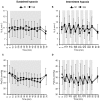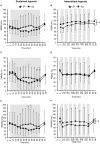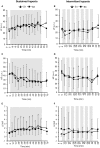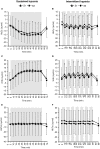Physiological Responses to Two Hypoxic Conditioning Strategies in Healthy Subjects
- PMID: 28119623
- PMCID: PMC5222853
- DOI: 10.3389/fphys.2016.00675
Physiological Responses to Two Hypoxic Conditioning Strategies in Healthy Subjects
Abstract
Objective: Hypoxic exposure can be used as a therapeutic tool by inducing various cardiovascular, neuromuscular, and metabolic adaptations. Hypoxic conditioning strategies have been evaluated in patients with chronic diseases using either sustained (SH) or intermittent (IH) hypoxic sessions. Whether hypoxic conditioning via SH or IH may induce different physiological responses remains to be elucidated. Methods: Fourteen healthy active subjects (7 females, age 25 ± 8 years, body mass index 21.5 ± 2.5 kg·m-2) performed two interventions in a single blind, randomized cross-over design, starting with either 3 x SH (48 h apart), or 3 x IH (48 h apart), separated by a 2 week washout period. SH sessions consisted of breathing a gas mixture with reduced inspiratory oxygen fraction (FiO2), continuously adjusted to reach arterial oxygen saturations (SpO2) of 70-80% for 1 h. IH sessions consisted of 5 min with reduced FiO2 (SpO2 = 70-80%), followed by 3-min normoxia, repeated seven times. During the first (S1) and third (S3) sessions of each hypoxic intervention, cardiorespiratory parameters, and muscle and pre-frontal cortex oxygenation (near infrared spectroscopy) were assessed continuously. Results: Minute ventilation increased significantly during IH sessions (+2 ± 2 L·min-1) while heart rate increased during both SH (+11 ± 4 bpm) and IH (+13 ± 5 bpm) sessions. Arterial blood pressure increased during all hypoxic sessions, although baseline normoxic systolic blood pressure was reduced from S1 to S3 in IH only (-8 ± 11 mmHg). Muscle oxygenation decreased significantly during S3 but not S1, for both hypoxic interventions (S3: SH -6 ± 5%, IH -3 ± 4%); pre-frontal oxygenation decreased in S1 and S3, and to a greater extent in SH vs. IH (-13 ± 3% vs. -6 ± 6%). Heart rate variability indices indicated a significantly larger increase in sympathetic activity in SH vs. IH (lower SDNN, PNN50, and RMSSD values in SH). From S1 to S3, further reduction in heart rate variability was observed in SH (SDNN, PNN50, and RMSSD reduction) while heart rate variability increased in IH (SDNN and RMSSD increase). Conclusions: These results showed significant differences in heart rate variability, blood pressure, and tissue oxygenation changes during short-term SH vs. IH conditioning interventions. Heart rate variability may provide useful information about the early adaptations induced by such intervention.
Keywords: blood pressure; heart rate variability; hypoxic conditioning; intermittent hypoxia; sustained hypoxia; tissue oxygenation.
Figures








Similar articles
-
Cardiovascular and metabolic responses to passive hypoxic conditioning in overweight and mildly obese individuals.Am J Physiol Regul Integr Comp Physiol. 2020 Aug 1;319(2):R211-R222. doi: 10.1152/ajpregu.00311.2019. Epub 2020 Jul 1. Am J Physiol Regul Integr Comp Physiol. 2020. PMID: 32609532 Clinical Trial.
-
Physiological responses to hypoxic constant-load and high-intensity interval exercise sessions in healthy subjects.Eur J Appl Physiol. 2019 Jan;119(1):123-134. doi: 10.1007/s00421-018-4006-9. Epub 2018 Oct 12. Eur J Appl Physiol. 2019. PMID: 30315366
-
Tissue deoxygenation kinetics induced by prolonged hypoxic exposure in healthy humans at rest.J Biomed Opt. 2013 Sep;18(9):095002. doi: 10.1117/1.JBO.18.9.095002. J Biomed Opt. 2013. PMID: 24064948
-
The Use of Simulated Altitude Techniques for Beneficial Cardiovascular Health Outcomes in Nonathletic, Sedentary, and Clinical Populations: A Literature Review.High Alt Med Biol. 2017 Dec;18(4):305-321. doi: 10.1089/ham.2017.0050. Epub 2017 Aug 28. High Alt Med Biol. 2017. PMID: 28846046 Review.
-
Cardiovascular alterations by chronic intermittent hypoxia: importance of carotid body chemoreflexes.Clin Exp Pharmacol Physiol. 2005 May-Jun;32(5-6):447-9. doi: 10.1111/j.1440-1681.2005.04209.x. Clin Exp Pharmacol Physiol. 2005. PMID: 15854156 Review.
Cited by
-
A comprehensive review of respiratory, autonomic and cardiovascular responses to intermittent hypoxia in humans.Exp Neurol. 2021 Jul;341:113709. doi: 10.1016/j.expneurol.2021.113709. Epub 2021 Mar 27. Exp Neurol. 2021. PMID: 33781731 Free PMC article. Review.
-
Cardiac Autonomic Modulation and Response to Sub-Maximal Exercise in Chilean Hypertensive Miners.Front Physiol. 2022 Apr 13;13:846891. doi: 10.3389/fphys.2022.846891. eCollection 2022. Front Physiol. 2022. PMID: 35492599 Free PMC article.
-
Hypoxic conditioning and the central nervous system: A new therapeutic opportunity for brain and spinal cord injuries?Exp Biol Med (Maywood). 2017 Jun;242(11):1198-1206. doi: 10.1177/1535370217712691. Exp Biol Med (Maywood). 2017. PMID: 28585890 Free PMC article. Review.
-
Cardiorespiratory Responses to Acute Intermittent Hypoxia in Humans With Chronic Spinal Cord Injury.J Neurotrauma. 2024 Sep;41(17-18):2114-2124. doi: 10.1089/neu.2023.0353. Epub 2024 Apr 18. J Neurotrauma. 2024. PMID: 38468543 Clinical Trial.
-
Intermittent Hypoxic-Hyperoxic Training During Inpatient Rehabilitation Improves Exercise Capacity and Functional Outcome in Patients With Long Covid: Results of a Controlled Clinical Pilot Trial.J Cachexia Sarcopenia Muscle. 2024 Dec;15(6):2781-2791. doi: 10.1002/jcsm.13628. Epub 2024 Nov 19. J Cachexia Sarcopenia Muscle. 2024. PMID: 39559920 Free PMC article.
References
-
- Almendros I., Farré R., Planas A. M., Torres M., Bonsignore M. R., Navajas D., et al. . (2011). Tissue oxygenation in brain, muscle, and fat in a rat model of sleep apnea: differential effect of obstructive apneas and intermittent hypoxia. Sleep 34, 1127–1133. 10.5665/sleep.1176 - DOI - PMC - PubMed
LinkOut - more resources
Full Text Sources
Other Literature Sources
Miscellaneous

